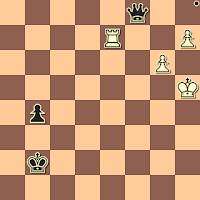!?!?
While the Jerome Gambit might, on the surface, appear to be a "simple" chess opening - so brutal as to be completely transparent - it can have its little surprises, which is part of what makes it attractive. Take the following game...
procyk - deriver69
Jerome Gambit Tournament, RedHotPawn.com, 2016
1.e4 e5 2.Nf3 Nc6 3.Bc4 Bc5 4.Bxf7+
4...Kxf7 5.c3 Nf6 6.O-O d6 7.d4 exd4 8.cxd4 Bb6 9.Qb3+ Ke7
It is interesting that Stockfish 7 prefers 9...d5 here, while a couple of other computers in game situations preferred 9...Kf8, e.g. 10.Qd3 (10.d5 Ne5 11.Nxe5 dxe5 12.Nc3 Ng4 13.h3 Bxf2+ 14.Rxf2+ Nxf2 15.Kxf2 Qh4+ 16.Kg1 Qg3 17.Nb5 Qxb3 18.axb3 c6 19.Nc7 Rb8 20.Be3 Bd7 21.Bxa7 Rd8 22.Rf1+ Kg8 23.Bc5 cxd5 24.exd5 h6 25.Re1 Rc8 26.d6 Rh7 27.b4 g6 28.Nd5 Rf8 29.Rxe5 Rhf7 30.Re1 Re8 31.Ne7+ Kh7 32.Ra1 Ref8 33.b3 Rf4 34.Ra7 Rb8 35.Bb6 Rf7 36.Bc7 Rbf8 37.Rxb7 Bxh3 38.Bb6 Bc8 39.Ra7 Be6 40.d7 Rf1+ 41.Kh2 Rd1 42.d8=Q Rdxd8 43.Bxd8 Rxd8 44.b5 Rd3 45.Nc6+ Kg8 46.b6 Rxb3 47.b7 Bc4 48.b8=Q+ Rxb8 49.Nxb8 Be6 50.Nc6 h5 51.Kg3 Kf8 52.Kf4 Bd5 53.Ne5 Bxg2 54.Nxg6+ Ke8 55.Kg5 Bf3 56.Nf4 Kd8 57.Nxh5 Kc8 58.Rg7 Be4 59.Kf4 Bc6 60.Ke5 Bf3 61.Nf4 Bc6 62.Ne6 Kb8 63.Kd6 Be4 64.Nd4 Kc8 65.Rc7+ Kb8 Black resigned, Rybka 2.3.2a - DrunkenMaster 1.2, 2009) 10...Qe7 11.Nc3 Bg4 12.Be3 Nb4 13.Qd2 Bxf3 14.gxf3 Kg8 15.Na4 Nc6 16.Rac1 Qf7 17.b4 Qg6+ 18.Kh1 Qh5 19.Qd1 Rc8 20.Nxb6 axb6 21.Rg1 Nxb4 22.Qb3+ Kf8 23.Qxb4 Qxf3+ 24.Rg2 Qxe4 25.Bg5 Qd5 26.Bxf6 gxf6 27.Qd2 h5 28.Qf4 f5 29.f3 Rh7 30.Rg6 Ra8 31.Rf6+ Ke8 32.Rxf5 Qg8 33.Qe4+ Kd8 34.Qxb7 Rc8 35.Rf6 Ke7 36.Rf4 Kd8 37.Re4 Qf7 38.f4 Rg7 39.Rce1 Rg8 40.Qc6 Qd7 41.Qd5 Qg4 42.Re7 Qg6 43.Qc6 Qg1+ 44.Rxg1 Rxg1+ 45.Kxg1 Kxe7 46.f5 Kf6 47.Qg2 Re8 48.Qg6+ Ke7 49.Qg7+ Kd8 50.f6 Kc8 51.f7 Black resigned, SOS 5.1 - DrunkenMaster, 2009.
In any event, Black appears to be doing well, having an extra piece for the cost of a pawn. True, his King has not found safety, but isn't that a trivial thing?
7.Bg5
White pins the Knight, setting up a hit on it with the e-pawn. It turns out that he can make the advance right away: 7.e5 dxe5 8.dxe5 Ne4 9.Ng5!? Here's a shocker; White recovers his piece. Stockfish 7 recommends 9...Qg8 10.Qxg8 Rxg8 11.Nxe4 h6 and White has a small edge.
7...Bg4 8.e5 dxe5
9.Nxe5
Deviating from the foretold 9.dxe5. Maybe he can still get a pawn to e5?
9...Nxe5
Black believes he has an antidote to all the mischief regarding the e5 pawn's attack on the pinned Knight at f6, but he should have played it - 9...Be6 - right away, as after 10.Nxc6+ bxc6 11.Re1 Qd6 he would be doing fine.
10.dxe5 Be6 11.exf6+ gxf6 12.Qa3+ Kf7
White has recovered his piece, and Black's King remains slightly exposed. If the first player can safeguard his Bishop, he should be able to keep the game level.
13.Bh4
This looks fine, but Stockfish 7 recommends the pin, 13.Qf3, instead, i.e. 13...Qd4 14.Nd2 Bg4 15.Qb3+ Be6 16.Qf3 and an invitation to draw by repetition. Existential anxiety?
13...Rg8
This proves to be the winning idea, but the computer prefers 13...Qd4 14.Bg3 h5 15.Qc3 h4 16.Qxd4 Bxd4 17.Bxc7 Bxb2 18.Nd2 Bxa1 19.Rxa1 Bd5 when Black is clearly better.
14.Nc3 Bd4 15.Ne2 Qd5 16.Rad1
Suddenly realizing that he had overlooked something, here White resigned






















